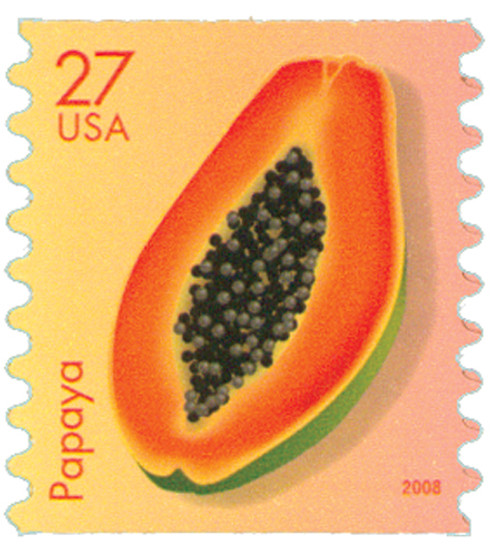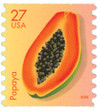
2008 27c Tropical Fruit: Papaya, coil
# 4258 - 2008 27c Tropical Fruit: Papaya, coil
$1.40 - $3.75
Tropical Fruit
Papaya
Die Cut 8.5
Issue Date: April 25, 2008
City: Burlingame, CA
The papaya (Carica papaya) is native to southern Mexico and Central America, and is now cultivated in a large number of tropical and subtropical countries. Papayas must be grown in areas that are warm throughout the entire year. Light frosts can damage the plants and cold, wet soil often kills them.
City: Burlingame, CA
The papaya (Carica papaya) is native to southern Mexico and Central America, and is now cultivated in a large number of tropical and subtropical countries. Papayas must be grown in areas that are warm throughout the entire year. Light frosts can damage the plants and cold, wet soil often kills them.
The two main varieties of papaya are Hawaiian and Mexican. Hawaiian papayas, more common in the U.S., are pear-shaped, weigh about one pound, and have yellow skin. The bright orange or pink flesh contains small black seeds that are clustered in the center. Mexican papayas weigh up to 10 pounds and can be over 15 inches long. The yellow, orange, or pink flesh does not have as intense a flavor as the Hawaiian papaya, but is easier to grow. The papaya’s black seeds have a tangy, spicy taste, and are often used as a seasoning similar to black pepper.
The flavorful papaya plant also has many medicinal uses. In countries where it is grown, fermented papaya flesh is ground into a paste and used as a topical ointment for cuts, rashes, stings, and burns. The fruit can also be used to treat high blood pressure, while the seeds and leaves can be used to treat stomachaches.
In 2008, the papaya was part of a set of Tropical Fruit stamps issued by the United States Postal Service.
Tropical Fruit
Papaya
Die Cut 8.5
Issue Date: April 25, 2008
City: Burlingame, CA
The papaya (Carica papaya) is native to southern Mexico and Central America, and is now cultivated in a large number of tropical and subtropical countries. Papayas must be grown in areas that are warm throughout the entire year. Light frosts can damage the plants and cold, wet soil often kills them.
City: Burlingame, CA
The papaya (Carica papaya) is native to southern Mexico and Central America, and is now cultivated in a large number of tropical and subtropical countries. Papayas must be grown in areas that are warm throughout the entire year. Light frosts can damage the plants and cold, wet soil often kills them.
The two main varieties of papaya are Hawaiian and Mexican. Hawaiian papayas, more common in the U.S., are pear-shaped, weigh about one pound, and have yellow skin. The bright orange or pink flesh contains small black seeds that are clustered in the center. Mexican papayas weigh up to 10 pounds and can be over 15 inches long. The yellow, orange, or pink flesh does not have as intense a flavor as the Hawaiian papaya, but is easier to grow. The papaya’s black seeds have a tangy, spicy taste, and are often used as a seasoning similar to black pepper.
The flavorful papaya plant also has many medicinal uses. In countries where it is grown, fermented papaya flesh is ground into a paste and used as a topical ointment for cuts, rashes, stings, and burns. The fruit can also be used to treat high blood pressure, while the seeds and leaves can be used to treat stomachaches.
In 2008, the papaya was part of a set of Tropical Fruit stamps issued by the United States Postal Service.










